Have you ever woken up feeling groggy, congested, or overheated—even after a full night’s sleep? Many people assume that their restless nights are caused by stress, diet, or screen time, but your HVAC system plays a bigger role in sleep quality than you might think. Temperature, air circulation, and humidity all directly impact how well you sleep. The wrong bedroom environment can lead to frequent waking, poor REM sleep, and even long-term health issues.
In this article, we’ll explore the science behind how your HVAC system influences sleep quality and provide actionable tips on optimizing your home’s heating, cooling, and air quality. By the end, you’ll know exactly how to create the perfect sleep environment using your HVAC system, so you can wake up feeling truly refreshed every morning.
Click on each corresponding link to jump ahead:
- The Ideal Bedroom Temperature for Optimal Sleep
- How Indoor Air Quality Impacts Sleep and Health
- Humidity Control: The Hidden Factor in Restful Sleep
- Noise Pollution: How a Noisy HVAC System Disrupts Sleep
- Smart HVAC Technology for Sleep Optimization
- The Impact of Carbon Dioxide (CO₂) and Ventilation on Sleep Quality
- The Role of Airflow and Mattress Temperature Regulation
- Conclusion: Unlocking Better Sleep Through HVAC Optimization
If you are interested in improving your sleep quality through upgraded HVAC services, Contact Service 1st today!
1) The Ideal Bedroom Temperature for Optimal Sleep
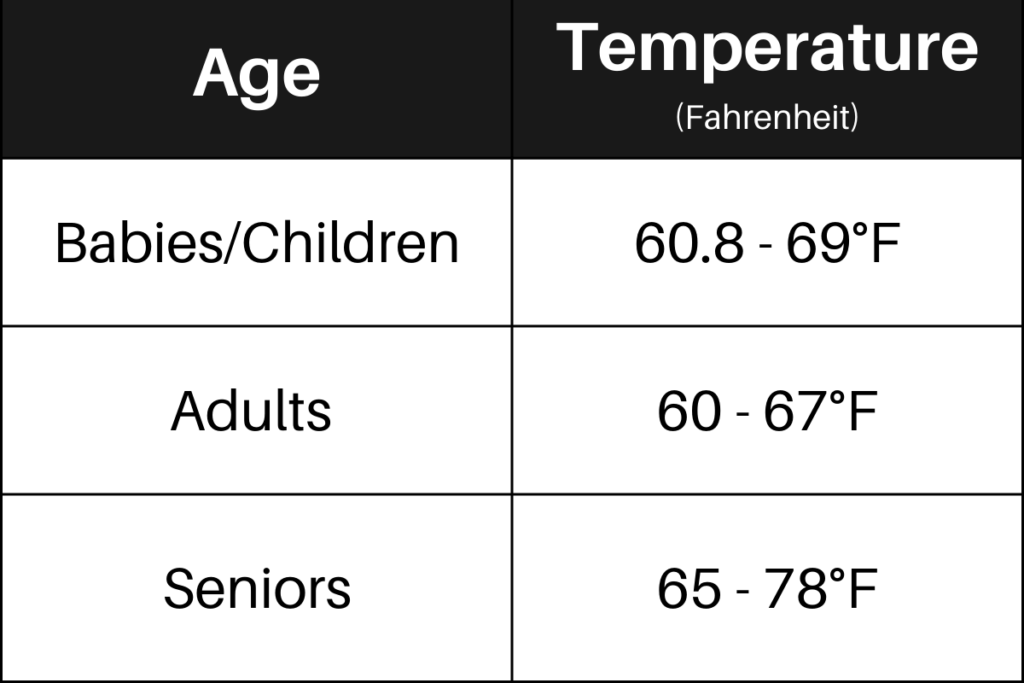
Source: Sleep Care Online
Why Temperature is the Key to Better Sleep
Many people overlook how temperature directly affects their sleep quality, but getting it right can make a significant difference. Research shows that the ideal bedroom temperature for optimal sleep falls between 60-67°F (15-19°C). This range is crucial because it supports your body’s natural sleep cycles, helping you fall asleep faster and stay asleep longer.
How Temperature Affects Sleep Quality
As you prepare to sleep, your body naturally cools down to trigger sleep onset. If the temperature is too high or too low, it can disrupt this process, making it harder to fall into deep, restorative sleep. A room that’s too warm can cause sweating, discomfort, and frequent waking during the night. On the other hand, if the room is too cold, your body expends energy trying to stay warm, which can lead to interrupted sleep and difficulty entering the deeper stages of rest.
For the best sleep, your environment should encourage your body to cool down naturally without the distraction of temperature fluctuations. A comfortable room within the 60-67°F range allows for deep sleep cycles, including REM sleep, which is essential for mental and physical recovery.
How to Achieve the Ideal Sleep Temperature
Here’s how you can optimize your bedroom environment for better sleep:
- Set Your Thermostat: Aim for a temperature within the 60-67°F (15-19°C) range. A programmable or smart thermostat can help you automatically adjust the temperature before bed and upon waking, keeping your room in the ideal setting without manual adjustments.
- Use Fans or Air Circulators: If you’re too warm, a fan or air circulator can help regulate airflow and cool the room down without needing to blast air conditioning.
- Choose the Right Bedding: Adjust your blankets and sheets based on the season. Cooling sheets for warmer months or thicker blankets in winter can help you maintain comfort without overheating or getting too cold.
- Pay Attention to Sleepwear: Lightweight, breathable fabrics like cotton are great for warm months, while warmer options can help keep you cozy during cooler nights.
2) How Indoor Air Quality Impacts Sleep and Health
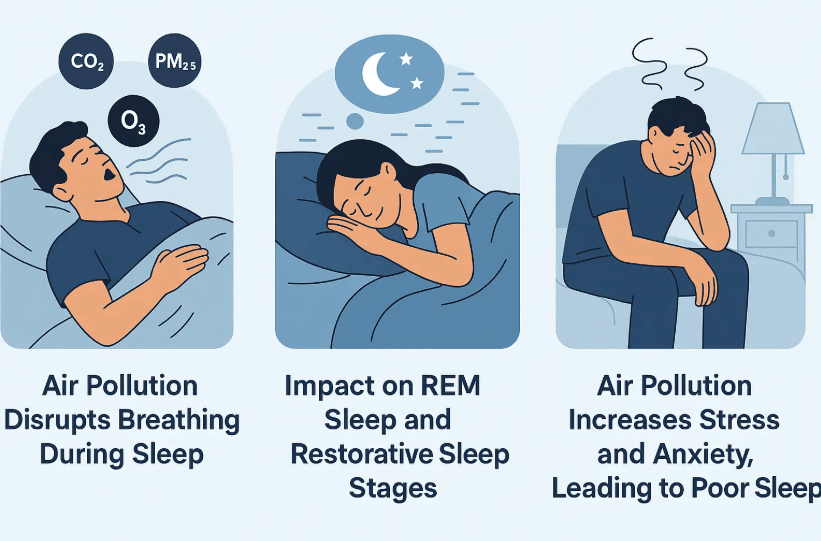
Source: Prana Air
Indoor air quality plays a crucial role in overall health and sleep quality. Poor air conditions can lead to allergies, congestion, and nighttime breathing difficulties, making it harder to get restful, uninterrupted sleep. Common airborne pollutants, such as dust, pollen, pet dander, and mold spores, can trigger allergic reactions and respiratory irritation, leading to snoring, dry throat, and difficulty breathing at night. Volatile organic compounds (VOCs) from household cleaning products, furniture, and paints can further degrade air quality, potentially causing headaches and sinus irritation that disrupt sleep cycles.
Additionally, imbalanced humidity levels can contribute to poor air conditions. High humidity fosters mold and dust mite growth, both of which aggravate allergies and asthma. On the other hand, overly dry air can irritate nasal passages and the throat, leading to discomfort and restless sleep. Ensuring proper ventilation and filtration can significantly enhance air quality and overall well-being.
To improve indoor air quality and create a healthier sleep environment, consider the following solutions:
- Use high-efficiency HVAC air filters (MERV 11+ or HEPA): These filters effectively capture fine particles like dust, pollen, and pet dander, preventing them from circulating through your HVAC system and triggering allergies.
- Install an air purifier: A high-quality air purifier with HEPA filtration can help remove airborne contaminants such as bacteria, mold spores, and VOCs, ensuring cleaner and fresher air in your bedroom.
- Schedule duct cleaning: Over time, dust, debris, and allergens build up in HVAC ducts, recirculating through the air every time your system runs. Regular duct cleaning helps eliminate these pollutants, reducing allergy triggers and improving airflow.
- Maintain balanced humidity levels: Use a humidifier in dry seasons to prevent throat irritation and a dehumidifier in humid conditions to prevent mold growth. Ideal indoor humidity levels range between 30% and 50%.
Expert Tip: Service 1st recommends seasonal HVAC maintenance to prevent dust and mold accumulation inside the system. Routine maintenance ensures optimal performance, helping to circulate clean air and reducing the presence of allergens that impact sleep quality.
3) Humidity Control: The Hidden Factor in Restful Sleep
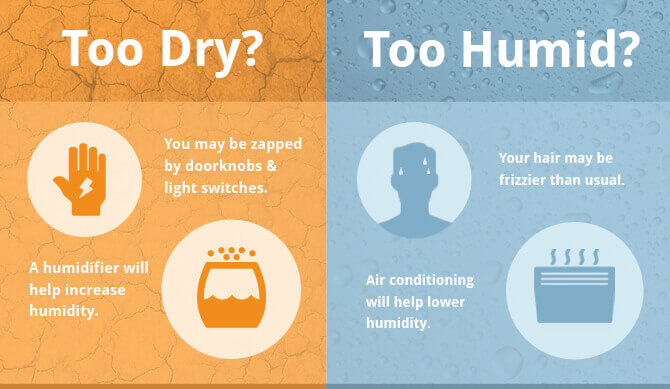
Source: Wattson Home Solutions
Maintaining proper home humidity levels is essential for a good night’s sleep. Excess humidity can create a breeding ground for mold, dust mites, and bacteria, leading to respiratory issues, congestion, and night sweating. On the other hand, air that is too dry can cause skin irritation, sore throats, and nasal dryness, making it difficult to breathe comfortably while sleeping. Studies suggest that the optimal indoor humidity range for sleep is between 40-50% relative humidity to ensure both comfort and health. (Source: EPA).
The Fix: How to Maintain the Best Humidity for Sleep
- Keep bedrooms at 40-50% relative humidity: This range helps prevent mold growth while keeping air moist enough to avoid dryness and irritation. (Source: Sleep Foundation).
- Use whole-home humidifiers and dehumidifiers: Integrated HVAC humidifiers and dehumidifiers automatically regulate indoor moisture, keeping the air balanced without manual adjustments. (Source: ASHRAE).
- Run ventilation systems: Proper ventilation, including exhaust fans and air exchangers, helps remove excess moisture from bathrooms and kitchens, preventing condensation buildup and mold growth. (Source: CDC).
- Smart HVAC integration: Modern thermostats equipped with humidity sensors can monitor and automatically adjust indoor moisture levels to maintain ideal comfort, reducing the risk of nighttime discomfort and sleep disturbances.
Expert Tip: Service 1st recommends pairing a smart thermostat with an integrated HVAC humidifier or dehumidifier for automated humidity control. This ensures year-round comfort and prevents seasonal fluctuations in indoor moisture levels that can disrupt sleep.
4) Noise Pollution: How a Noisy HVAC System Disrupts Sleep

Source: Dauenhauer Plumbing
Unwanted noise from an HVAC system can negatively impact sleep quality, making it harder to fall and stay asleep. Loud furnaces, air conditioners, or ductwork vibrations create disruptions that prevent deep, restorative rest. Research suggests that prolonged exposure to nighttime noise can elevate stress hormones like cortisol, increasing the risk of high blood pressure and heart disease.
One of the most effective ways to reduce HVAC noise is by upgrading to a variable-speed system. Traditional HVAC units operate at full power when they turn on, producing sudden and often loud noises. A variable-speed system, however, runs more quietly by adjusting airflow gradually, minimizing disruptive sounds while maintaining consistent indoor comfort. (Source: ENERGY STAR).
Ductwork can also be a major source of noise, especially if it is made of thin metal that amplifies vibrations. Insulated ductwork helps absorb sound and prevents the noise from travelling through the home. Securing loose ducts and sealing gaps can further reduce rattling and pressure-related noise. (Source: ASHRAE).
Regular HVAC maintenance is essential for keeping noise levels under control. Over time, fan motors, blower wheels, and duct connections can loosen or wear out, leading to excessive noise. Routine inspections help detect and resolve these issues before they become a major disturbance. (Source: Department of Energy).
A quieter HVAC system creates a better sleep environment by minimizing nighttime disturbances. Service 1st recommends scheduling seasonal inspections to identify and fix potential noise issues early, ensuring a peaceful and comfortable home.
5) Smart HVAC Technology for Sleep Optimization
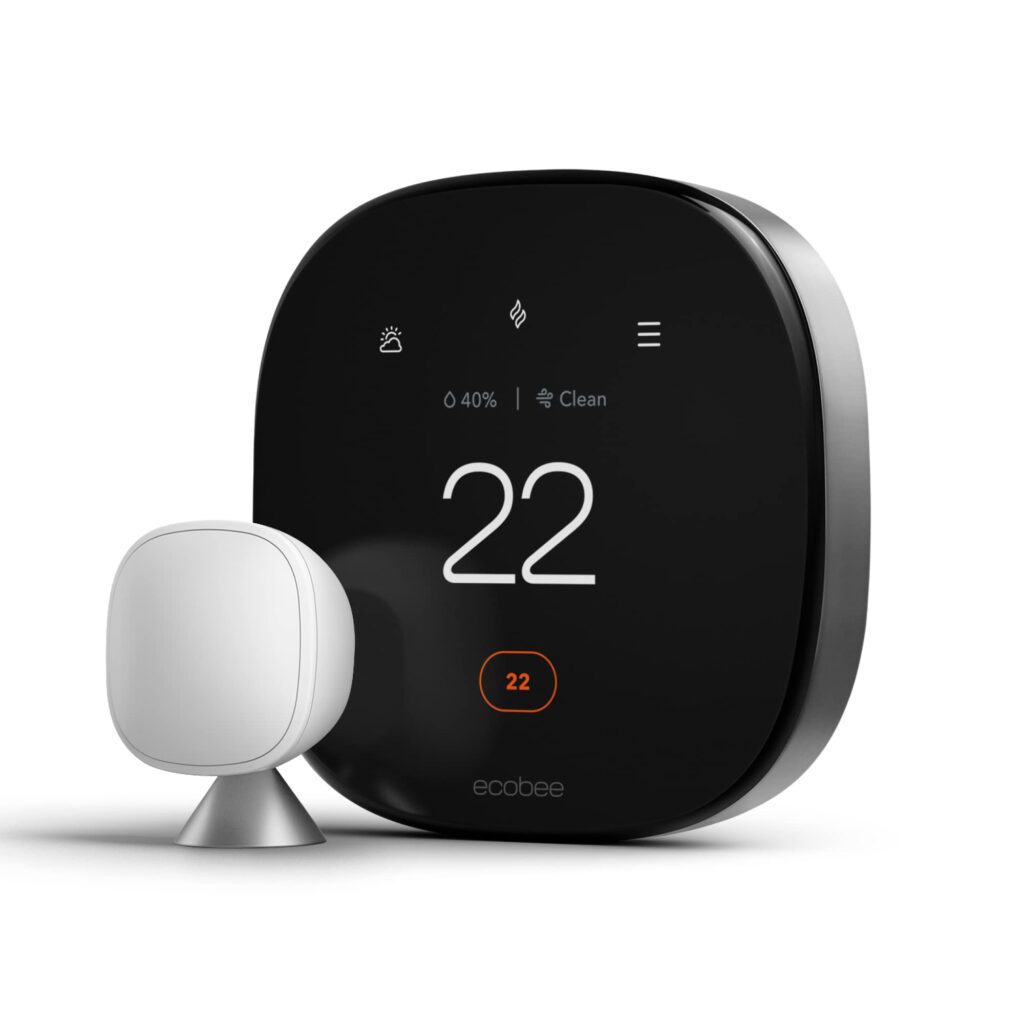
Source: Amazon
As technology advances, smart HVAC systems are revolutionizing how we control our home environment, particularly when it comes to optimizing sleep. These systems can learn your sleep patterns and make automatic adjustments to temperature, airflow, and humidity levels, creating the ideal conditions for restful sleep. By integrating smart HVAC technology into your home, you can ensure that your sleep environment is consistently comfortable, without having to manually adjust settings throughout the night.
One of the most important features for sleep optimization is Wi-Fi-enabled thermostats. These thermostats allow you to set and program sleep-friendly temperature settings directly from your smartphone, even when you’re away from home. This gives you the flexibility to ensure the temperature is perfect when you’re ready to sleep. Many of these thermostats also have learning capabilities, meaning they can adjust to your preferences over time, further improving your sleep quality. (Source: ENERGY STAR).
Motion sensors are another key feature in modern smart HVAC systems. These sensors detect when you’re asleep and adjust air circulation accordingly. This ensures that you’re not wasting energy or disrupting your sleep with unnecessary airflow. As a result, the system works more efficiently, creating a more comfortable and energy-efficient environment.
Voice-controlled HVAC systems are becoming increasingly popular for their convenience. With systems like Amazon Alexa, Google Assistant, or Apple Siri, you can easily adjust your home’s temperature or airflow without even getting out of bed. Whether it’s lowering the temperature slightly for better sleep or increasing airflow for better circulation, voice control allows for quick and easy adjustments in the middle of the night. (Source: CNET).
When choosing the right smart thermostat for sleep optimization, a few top picks stand out. The Nest Learning Thermostat, Ecobee SmartThermostat, and Honeywell Home T9 Smart Thermostat all offer excellent temperature control, advanced learning features, and seamless integration with other smart devices. These models allow you to create a customized sleep environment that adjusts automatically based on your preferences, ensuring a restful night’s sleep. (Source: Consumer Reports).
Integrating smart HVAC technology into your home can make a significant difference in your sleep quality. With automatic adjustments to temperature, airflow, and humidity, you can rest easy knowing that your environment is optimized for comfort.
6) The Impact of Carbon Dioxide (CO₂) and Ventilation on Sleep Quality
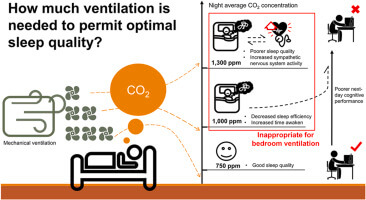
Source: Science Direct
The quality of the air you breathe at night plays a critical role in how well you sleep. High levels of carbon dioxide (CO₂) in your bedroom can cause feelings of grogginess, headaches, and general restlessness, making it more difficult to achieve a restful night’s sleep. CO₂ levels rise when the room is poorly ventilated, and as CO₂ accumulates, oxygen circulation in the room decreases, further impacting sleep quality. Ensuring that your bedroom has adequate ventilation can help reduce these negative effects and support better sleep.
Poor ventilation is one of the primary contributors to elevated CO₂ levels. Inadequate airflow traps stale air, causing a buildup of CO₂, which disrupts the balance of oxygen in the room. This lack of fresh air circulation can leave you feeling tired upon waking and can even contribute to headaches or difficulty concentrating during the day. (Source: National Institutes of Health).
One of the most effective ways HVAC systems can address this issue is through the installation of an energy recovery ventilator (ERV) or heat recovery ventilator (HRV). These systems are designed to bring in fresh outdoor air while expelling stale indoor air, ensuring a constant flow of oxygen-rich air throughout the room. They are particularly helpful in areas where energy efficiency is important, as they precondition the incoming air, making the process more energy-efficient without compromising indoor air quality. (Source: U.S. Department of Energy).
Additionally, keeping bedroom air vents open and unblocked is crucial for ensuring proper airflow and reducing CO₂ buildup. If vents are obstructed, the circulation of fresh air is limited, contributing to poor air quality.
For more advanced solutions, upgrading to a smart HVAC system that can detect CO₂ levels in real-time and automatically adjust ventilation accordingly offers an excellent way to maintain optimal indoor air quality. These systems monitor air quality and adjust settings to ensure proper ventilation throughout the night, helping prevent CO₂ buildup before it becomes an issue.
Pro Tip: A simple yet effective method for reducing CO₂ levels is to open bedroom doors at night. This promotes better airflow and prevents CO₂ from accumulating in closed-off spaces, improving the overall quality of the air in your room.
By addressing CO₂ levels and improving ventilation, you can significantly enhance your sleep environment, leading to more restful nights and better overall health.
7) The Role of Airflow and Mattress Temperature Regulation
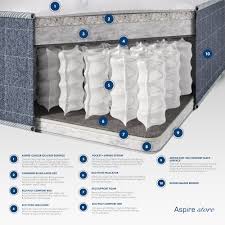
Lorem ipsum dolor sit amet, consectetur adipiscing elit. Ut elit tellus, luctus nec ullamcorper mattis, pulvinar dapibus leo.
Even with your thermostat set to the ideal temperature for sleep, poor air circulation can still make your bedroom feel stuffy, warm, and uncomfortable. Without proper airflow, air becomes stagnant, making it harder for your body to cool down and get the restful sleep it needs. In addition, some mattresses trap body heat, preventing your body from reaching an optimal sleep temperature and leading to restless nights. Improving both airflow and mattress temperature regulation can help you achieve a more comfortable, sleep-friendly environment.
Improving Airflow for Better Sleep
To ensure even cooling and proper ventilation in your bedroom, consider adding a ceiling fan or an oscillating fan. These will help distribute cool air evenly throughout the room, preventing warm pockets of air from forming. Ceiling fans, in particular, can circulate air efficiently without creating noise disruptions, which also enhances sleep quality.
Make sure that your HVAC vents are not blocked by furniture, curtains, or any other obstructions that can restrict airflow. Proper airflow is essential for even cooling, and blocked vents can cause certain areas of your room to feel hotter or stuffier.
If you find that certain rooms in your home don’t receive enough airflow, you might want to consider installing a duct booster fan. These devices help increase air circulation to specific rooms, ensuring that your entire home receives adequate airflow, which can improve the overall thermal comfort of your sleeping environment.
How to Keep Your Bed Cool
If your mattress traps body heat, it can make it difficult to cool down at night. Consider investing in a gel-infused mattress or one designed with breathable materials that actively regulate temperature. These mattresses help disperse heat, providing a cooler surface for sleeping.
Additionally, cooling bed sheets made from linen or moisture-wicking materials can help draw heat away from your body, keeping you cool throughout the night. These fabrics allow for better airflow and moisture evaporation, which can help maintain an ideal sleep temperature.
Another tip is to position your bed away from heating vents, as direct exposure to warm air can create uncomfortable pockets of heat while you sleep. Ensure that air from the vents isn’t blowing directly onto your bed to avoid disturbances in your sleep environment.
Bonus Tip: Modern smart HVAC systems with individual room sensors can take temperature control to the next level. These systems automatically adjust airflow based on real-time readings from sensors placed in different rooms. This provides personalized thermal comfort throughout the night, ensuring that each area of your home, including your bedroom, maintains an ideal temperature for restful sleep.
By improving airflow, cooling your bed, and optimizing HVAC settings, you can create a more comfortable and sleep-friendly environment that supports better sleep quality.
8) Unlocking Better Sleep Through HVAC Optimization

Achieving a good night’s sleep goes beyond a comfortable mattress or blackout curtains—your HVAC system plays a critical role. As we’ve explored, HVAC sleep optimization involves fine-tuning key factors that directly impact sleep quality. Maintaining the best home temperature for sleep—typically between 60–67°F (15–19°C)—helps regulate your body’s internal thermostat. Meanwhile, proper humidity control prevents irritants like dry air or excess moisture from disturbing your rest.
Clean, well-filtered air contributes to better air quality and health, reducing allergens and respiratory irritants that can interfere with breathing and sleep cycles. Noise control, another overlooked element, can be enhanced by selecting quiet HVAC units and ensuring proper insulation. Finally, integrating smart thermostats and automation allows your system to adapt in real time to your sleep patterns for optimal comfort and energy efficiency.
Ready to transform your nights? Schedule an HVAC inspection with Service 1st today. Our experts will assess your system and recommend a personalized, sleep-friendly upgrade—so you can wake up refreshed and healthier, every day.





